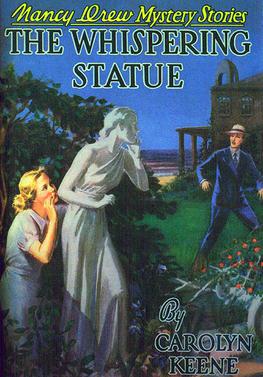The Whispering Statue facts for kids

Original edition cover
|
|
| Author | Carolyn Keene |
|---|---|
| Illustrator | Russel H. Tandy |
| Cover artist | Russell H. Tandy |
| Country | United States |
| Language | English |
| Series | Nancy Drew Mystery Stories |
| Genre | Juvenile literature |
| Publisher | Grosset & Dunlap |
|
Publication date
|
1937, 1970 |
| Media type | Print (Hardback & Paperback) |
| Pages | 179 |
| ISBN | 0-448-09514-9 |
| OCLC | 514896 |
| LC Class | PZ7.K23 Nan no. 14 1970 |
| Preceded by | The Mystery of the Ivory Charm |
| Followed by | The Haunted Bridge |
The Whispering Statue is the fourteenth volume in the Nancy Drew Mystery Stories series. It was written by Mildred Wirt Benson, whom many readers and scholars consider the "truest" of the numerous Carolyn Keene ghostwriters, following an outline by Harriet Stratemeyer. The book was originally published by Grosset & Dunlap in 1937. An updated, revised, and largely different story was published under the same title in 1970.
Plot summary - 1937 edition
Nancy, Bess, and George encounter a troublesome stray terrier on their way to the opening festivities of a new park and recreation complex in River Heights. The terrier grabs the handbag of one of the guest speakers and loses it in a nearby pond. Nancy helps groundskeepers retrieve the handbag and uses the notes found inside to prompt the nervous speaker during her address. She also finds a mysterious personal ad in the handbag. In a casual observation, the "clubwoman," a Mrs. Owen, tells Nancy about a statue on a deserted seaside estate. The statue, known as "The Whispering Girl," bears an uncanny resemblance to Nancy. As it turns out, Nancy is bound for that very area with her father and her friends Bess and George.
Reluctantly, Nancy decides to keep the terrier for a little while, dubbing him Togo (after a famous Alaskan husky, who in turn was named after a Japanese admiral). Togo follows her to the train station, and she has no choice but to bring him to Sea Cliff with her. On the train, the girls observe a strange elderly woman identified as a Miss Morse, and they suspect a man who has just approached the woman is trying to swindle her.
Once in Sea Cliff, the girls hunt for the statue that resembles Nancy – and for Miss Morse, who has excited Nancy's curiosity and protectiveness. Further mysterious complications occur when Miss Morse acknowledges that she is being swindled but dismisses Nancy and when Nancy happens to overhear the crook from the train boasting about his conquest. There are several encounters with quirky but ultimately helpful older men. A seaplane accident leads Nancy to rescue a client of her father who is then linked both to Mrs. Owen and to the mysterious Miss Morse. In the long climactic sequence of the story, Nancy hides behind the statue and uses her voice to make the statue appear to speak to the con man from the train. She is also captured and tied up, and as she confronts one of the novel's many miscreants, the cliffside mansion falls into the ocean, necessitating another dramatic rescue.
This edition of the novel is considered one of the most ragged, overpopulated, and coincidence-heavy of the series. It does, however, introduce the enduringly popular Togo, who becomes a mainstay in the series thereafter.
1970 revision
Nancy is asked to solve a puzzling mystery, whereupon she encounters a second case. The first mystery concerns a valuable collection of rare books. Wealthy Mrs. Horace Merriam has commissioned a supposedly reputable art dealer to sell the collection, but she now suspects that the man is a swindler who is not giving Mrs. Merriam her portion of the proceeds. The second mystery involves the baffling theft of a beautiful marble statue, which is thought to "whisper," and which bears an uncanny resemblance to Nancy. She becomes an undercover employee of the dealer, with the alias Debbie Lynbrook. The mystery becomes complicated when the returned marble statue is discovered to be fake. An attempted kidnapping, a nearly disastrous sailboat collision, and an encounter with a dishonest sculptor are just a few of the exciting challenges that Nancy is faced with as she gathers evidence against a clever ring of art thieves.
Artwork
The original 1937 cover art is by Russell H. Tandy, and shows Nancy crouched behind a statue, speaking to a man. Rudy Nappi illustrated the same scene for the 1962 picture cover edition, with updated clothing and hairstyles. Nappi also illustrated the cover of the 1970 edition, which is predominantly blue and white, featuring Nancy's profile behind an overlay of a statue.

